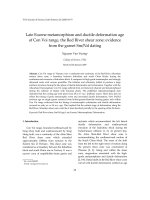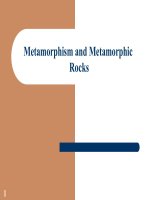G225 metamorphism
Bạn đang xem bản rút gọn của tài liệu. Xem và tải ngay bản đầy đủ của tài liệu tại đây (4.3 MB, 66 trang )
Metamorphism – changes in mineralogy and texture
brought about by perturbations in heat and pressure
Compositional changes are generally restricted to those
related to devolatilization
Metamorphism involves the recrystallization of a rock
Metasomatism involves mass transfer, not just
devolatilization ; commonly, introduced fluids carry
elemental constituents that react with minerals to form
new minerals. These fluid may be of various origins, but
often they are derived from magmas (which crystallize as
igneous plutonic rocks) which are also supplying heat.
Types of metamorphism
• Contact – high T, low P
• Hydrothermal – involving a fluid; often referred to as
hydrothermal alteration
• Regional – high T, can be high P
• Burial – a continuation of diagenesis; related to burial in
a sedimentary basin without active tectonism or
plutonism
T – P ranges are 100-800 OC and 1
bar(105Pa) to 10 kb (109 Pa)
Contact metamorphic aureole
Chapter 22: Foliated
Metamorphic Rocks
Slate: compact, very finegrained, metamorphic rock
with a well-developed
cleavage. Freshly cleaved
surfaces are dull
Phyllite: a rock with a
schistosity in which very fine
phyllosilicates
(sericite/phengite and/or
chlorite), although rarely
coarse enough to see unaided,
impart a silky sheen to the
foliation surface. Phyllites
with both a foliation and
lineation are very common.
a
b
Figure 22-1. Examples of foliated metamorphic rocks. a. Slate. b. Phyllite. Note the difference in reflectance on the foliation
surfaces between a and b: phyllite is characterized by a satiny sheen. Winter (2001) An Introduction to Igneous and Metamorphic
Petrology. Prentice Hall.
Chapter 22: Foliated
Metamorphic Rocks
Schist: a metamorphic rock
exhibiting a schistosity. By
this definition schist is a
broad term, and slates and
phyllites are also types of
schists. In common usage,
schists are restricted to those
metamorphic rocks in which
the foliated minerals are
coarse enough to see easily in
hand specimen.
Figure 22-1c. Garnet muscovite schist. Muscovite crystals are visible and silvery, garnets occur as large dark porphyroblasts.
Winter (2001) An Introduction to Igneous and Metamorphic Petrology. Prentice Hall.
Chapter 22: A Classification of
Metamorphic Rocks
Additional Modifying Terms:
Porphyroblastic means that a metamorphic rock has
one or more metamorphic minerals that grew much
larger than the others. Each individual crystal is a
porphyroblast
Some porphyroblasts, particularly in low-grade contact
metamorphism, occur as ovoid “spots”
If such spots occur in a hornfels or a phyllite
(typically as a contact metamorphic overprint over a
regionally developed phyllite), the terms spotted
hornfels, or spotted phyllite would be appropriate.
Garnet Porphroblasts
Chapter 22: A Classification of
Metamorphic Rocks
Figure 23-14b. Spotted Phyllite. Winter (2001) An Introduction to Igneous and Metamorphic Petrology. Prentice Hall.
Chapter 22: Foliated
Metamorphic Rocks
Gneiss: a metamorphic rock
displaying gneissose
structure. Gneisses are
typically layered (also called
banded), generally with
alternating felsic and darker
mineral layers. Gneisses may
also be lineated, but must
also show segregations of
felsic-mineral-rich and darkmineral-rich concentrations.
Figure 22-1d. Quartzo-feldspathic gneiss with obvious layering. Winter (2001) An Introduction to Igneous and Metamorphic
Petrology. Prentice Hall.
Slate
Schist
Phyllite
Gneiss
Foliation
Gneissic texture
Chapter 22: Specific
Metamorphic Rock Types
Marble: a metamorphic rock composed
predominantly of calcite or dolomite. The
protolith is typically limestone or dolostone.
Quartzite: a metamorphic rock composed
predominantly of quartz. The protolith is
typically sandstone. Some confusion may
result from the use of this term in sedimentary
petrology for a pure quartz sandstone.
Chapter 22: Non-Foliated
Metamorphic Rocks
Simpler than for foliated rocks
Again, this discussion and classification applies only to
rocks that are not produced by high-strain
metamorphism
Granofels: a comprehensive term for any isotropic rock
(a rock with no preferred orientation)
Hornfels is a type of granofels that is typically very
fine-grained and compact, and occurs in contact
aureoles. Hornfelses are tough, and tend to splinter
when broken.
Chapter 22: Specific
Metamorphic Rock Types
Skarn: a contact metamorphosed and silica
metasomatized carbonate rock containing
calc-silicate minerals, such as grossular,
epidote, tremolite, vesuvianite, etc. Tactite is a
synonym.
Granulite: a high grade rock of pelitic, mafic, or
quartzo-feldspathic parentage that is
predominantly composed of OH-free minerals.
Muscovite is absent and plagioclase and
orthopyroxene are common.
Chapter 22: Specific
Metamorphic Rock Types
Greenschist/Greenstone: a low-grade metamorphic
rock that typically contains chlorite, actinolite,
epidote, and albite. Note that the first three minerals
are green, which imparts the color to the rock. Such
a rock is called greenschist if foliated, and
greenstone if not. The protolith is either a mafic
igneous rock or graywacke.
Amphibolite: a metamorphic rock dominated by
hornblende + plagioclase. Amphibolites may be
foliated or non-foliated. The protolith is either a mafic
igneous rock or graywacke.
Chapter 22: Specific
Metamorphic Rock Types
Serpentinite: an ultramafic rock metamorphosed at low
grade, so that it contains mostly serpentine.
Blueschist: a blue amphibole-bearing metamorphosed
mafic igneous rock or mafic graywacke. This term is
so commonly applied to such rocks that it is even
applied to non-schistose rocks.
Eclogite: a green and red metamorphic rock that
contains clinopyroxene and garnet (omphacite +
pyrope). The protolith is typically basaltic.
Eclogite









